
TNU Journal of Science and Technology
230(03): 62 - 68
http://jst.tnu.edu.vn 62 Email: jst@tnu.edu.vn
APPLYING NOTE-TAKING SKILLS TO ENHANCE
FIRST- YEAR UNIVERSITY STUDENTS’ RECEPTIVE ENGLISH SKILLS
Nguyen Hanh Dao*, Nguyen Van Hai Dang
Faculty of Foreign Languages - Hanoi University of Science and Technology
ARTICLE INFO
ABSTRACT
Received:
11/12/2024
This study is aimed to identify how first-year English-majored students
at a Vietnam university might use notetaking to enhance their English-
language receptive skills. In order to achieve this objective, data from
a focus group interview of three research participants were collected
and analysed through theme-based coding methods. Three themes
were based on to analyze the collected data: (i) sub-skills used to take
notes of English documents, (ii) application of notetaking to progress
in reading and listening English documents, and (iii) benefits gained
from these applications. The findings were drawn from the data
analysis including the sub-notetaking skills three participants used to
improve their English language receptive skills and the ways they
applied notetaking to improve those language skills. Some pedagogical
implications have been made for concerned stake holders.
Revised:
27/3/2025
Published:
28/3/2025
KEYWORDS
Note-taking
English-language receptive skills
Sub-skills
Case studies
Theme- based coding data
analysis methods
ÁP DỤNG KHẢ NĂNG GHI CHÚ NHẰM HỖ TRỢ SINH VIÊN ĐẠI HỌC
NĂM THỨ NHẤT NÂNG CAO KỸ NĂNG TIẾP NHẬN TIẾNG ANH
Nguyễn Hạnh Đào* , Nguyễn Văn Hải Đăng
Khoa Ngoại ngữ - Đại học Bách khoa Hà Nội
THÔNG TIN BÀI BÁO
TÓM TẮT
Ngày nhận bài:
11/12/2024
Nghiên cứu này nhằm mục đích phát hiện cách sinh viên năm thứ nhất
ngành Ngôn ngữ Anh tại một trường đại học ở Việt Nam có thể sử
dụng kỹ năng ghi chú để cải thiện kỹ năng nghe và đọc tiếng Anh. Để
đạt được mục tiêu, nhóm nghiên cứu đã thu thập dữ liệu từ bài phỏng
vấn ba sinh viên. Việc phân tích dữ liệu phỏng vấn được thực hiện dựa
vào phương pháp mã hóa theo chủ đề. Ba chủ đề gồm: (i) các kỹ năng
dùng để ghi chú tài liệu tiếng Anh; (ii) áp dụng kỹ năng ghi chú nhằm
cải thiện khả năng đọc và viết tiếng Anh; và (iii) các lợi ích thu được
từ việc áp dụng này. Kết quả phân tích dữ liệu cho thấy ba sinh viên
trong nghiên cứu tình huống này đã sử dụng một số kỹ năng ghi chú
nhất định nhằm nâng cao kỹ năng nghe và đọc tiếng Anh và họ đã
dùng một vài cách để đạt được sự tiến bộ này. Từ kết quả nghiên cứu
trên, nhóm nghiên cứu đề xuất một số gợi ý cho các nhà giáo dục,
người học và các đối tượng liên quan khác.
Ngày hoàn thiện:
27/3/2025
Ngày đăng:
28/3/2025
TỪ KHÓA
Kỹ năng ghi chú
Kỹ năng tiếp nhận ngôn ngữ
Kỹ năng chi tiết
Phương pháp nghiên cứu tình
huống
Phương pháp phân tích dữ liệu
dựa vào mã hóa chủ đề
DOI: https://doi.org/10.34238/tnu-jst.11677
* Corresponding author. Email: dao.nguyenhanh@hust.edu.vn

TNU Journal of Science and Technology
230(03): 62 - 68
http://jst.tnu.edu.vn 63 Email: jst@tnu.edu.vn
1. Introduction
Nowadays, to catch up with swift international updates, students must learn English as it is the
second most popularly used language in the world. Among a large number of ways to study
English, note-taking is still an advanced technique which can be useful to support the understanding
of the language, keeping the knowledge in the long-term memory, and improving their English-
language receptive skills, namely reading skills and listening skills [1]. The literature on note-
taking highlights its critical role in enhancing the learning and comprehension of students. Boch
and Piolat [2] emphasize that note-taking is a fundamental skill for personal knowledge
management, allowing students to record key information and support reflection. This process
helps learners develop creativity through self-generated systems of signals and symbols to jot down
important points. Additionally, note-taking supports comprehension by forcing students to actively
seek primary ideas and supporting facts, which they can then compile and rearrange logically.
Kotorowicz-Jasińska [3] further identified essential sub-skills for effective note-taking, such as
distinguishing between relevant and irrelevant information, paraphrasing, and using acronyms and
symbols. These skills enable students to save time and avoid missing critical details, thereby
enhancing their overall learning efficiency.
Moreover, the application of note-taking in language learning has been extensively studied.
Cojean & Grand [4] described note-taking as a process of gathering information from various
sources, which can be done manually or digitally. This skill is particularly beneficial for language
learners, as it aids in retaining knowledge in long-term memory and improving receptive language
skills, such as reading and listening [5]. Özçakmak [6] underscored the importance of background
knowledge in organizing notes logically, which can significantly improve comprehension. By
employing structured note-taking methods, students can systematically break down complex texts
and enhance their understanding. These studies collectively suggested that tailored note-taking
strategies can significantly support the academic performance and language learning outcomes of
students. Besides that, according to Roessingh [7], when applying note-taking to enhance the
English-language listening skills of students, students can gain numerous advantages which
contribute to their task achievement [8]. Various sub-skills of note-taking, such as paraphrasing,
summarization, categorization, and keyword extraction, play a crucial role in improving
comprehension and retention. According to Piolat, Olive, and Kellogg [9], summarization helps
students distill key ideas from complex texts, while paraphrasing allows them to restate information
in their own words, reinforcing understanding. Categorization is another critical skill that enables
learners to organize related concepts effectively, which improves recall and cognitive processing
[2]. Keyword extraction allows learners to focus on essential terms and main ideas, making
information retrieval more efficient. Effective note-taking methods, including the Cornell method,
mapping, charting, and the sentence method, have been shown to aid learners in processing and
recalling information more efficiently [10].
Recent studies further support the importance of effective note-taking. Boch and Piolat [2]
discussed the principal functions of note-taking, including recording information and aiding
reflection, which are crucial for academic success. Jin &Webb [11] provided evidence that note-
taking through exposure to L2 input significantly enhances language learning, and Roessingh [7]
emphasized the cognitive benefits of handwritten notes for memory retention and comprehension.
Besides that, Kiewra [12] highlighted the effectiveness of providing instructor's notes to
complement student note-taking, enhancing overall learning outcomes while Makany et al.[13]
explored how optimizing note-taking strategies can serve as an external cognitive aid to boost
learning. Meanwhile, Mueller et al. [14] demonstrated the advantages of longhand note-taking over
laptops in terms of comprehension and retention. Buiet al. [15] investigated alternative note-taking
strategies with computers to improve recall. In fact, Özçakmak [6] examined the impact of note-
taking during reading and listening on comprehension, whereas Rahmani [17] studied the effect of

TNU Journal of Science and Technology
230(03): 62 - 68
http://jst.tnu.edu.vn 64 Email: jst@tnu.edu.vn
note-taking strategies instruction on the listening comprehension of EFL learners. Using another
approach, Morehead et al. [16] replicated and extended previous findings on the superiority of pen
over keyboard for note-taking.
Under the light of the above-mentioned literature review, in this exploratory study, an interview
of three students was carried outto identify how they have used note-taking to enhance their
receptive language skills. The study specifically examined how different note-taking sub-skills,
such as summarization, paraphrasing, categorization, and keyword extraction, contributed to their
development in reading and listening comprehension. Three research questions would be answered
in the research:
1. What specific sub-skills did those three research participants use when taking notes of
reading and listening texts?
2. How did they apply note-taking skills in reading and listening texts?
3. By applying those note-taking skills, how have they enhanced their ways of learning
English-language receptive skills?
2. Research methodology
This research employed a case study design to comprehensively examine the behavior patterns
and causes within a specific context, as defined by Yin [18]. Utilizing a qualitative approach, the
data were collected through focus-group interviews of three first-year English-majored students to
capture the actual effects of the experiences of the participants [19].
The research participants were selected for the case study due to their relevance to the objective
of the study, which is to explore how note-taking helped first-year English-majored students
improve their receptive language skills [18]. These participants, being first-year students majoring
in English, provided data that is directly pertinent to the research questions. Additionally, their
diverse backgrounds in note-taking offered a comprehensive view of different strategies and their
effectiveness. For instance, Student A used note-taking since grade 2, providing insights into long-
term benefits and techniques [2]. Student B, who started note-taking in her first year of university,
offered a perspective on the immediate impact of note-taking on receptive skills [2]. Student C,
who began note-taking in grade 11, allowed for an understanding of how note-taking skills
developed during high school can influence university-level learning Kotorowicz-Jasińska [3]. All
participants had studied English since primary school, ensuring a consistent baseline in their
language proficiency, which helps isolate the impact of note-taking on their receptive skills [6].
The gender homogeneity of the participants, all being female, helps control for gender-related
variables in learning and note-taking behaviors, making the findings more focused and specific [7].
Furthermore, the participants were from the Faculty of Foreign Languages at Hanoi University of
Science and Technology (FOFL–HUST), providing a specific institutional context that is useful
for understanding the application of note-taking strategies in a particular educational setting [18].
By selecting these participants, the study ensured a detailed and nuanced exploration of the
effectiveness of note-taking strategies among first-year English-majored students, as they shared
common educational backgrounds while also offering diverse experiences with note-taking.
The focus-group interview conducted for this study lasted approximately 60 minutes and
included a total of 10 questions, divided among three main aspects of note-taking. For the sub-
skills used in note-taking, 3 questions were asked to identify specific techniques such as using short
forms, paraphrasing, and distinguishing between relevant and irrelevant information. To explore
the application of note-taking for language learning progress, 4 questions were posed, focusing on
how participants applied their note-taking skills in reading and listening tasks, and how these
applications helped them organize their notes and improve comprehension. Lastly, 3 questions
addressed the benefits of note-taking for enhancing receptive skills, investigating improvements in
listening and reading comprehension, the ability to recall information, and overall academic

TNU Journal of Science and Technology
230(03): 62 - 68
http://jst.tnu.edu.vn 65 Email: jst@tnu.edu.vn
performance. This structured approach ensured a comprehensive exploration of the experiences of
the participants and insights into the effectiveness of note-taking strategies.
In terms of data analysis methods, thematic coding and discourse analysis of the interview data
were used. On the one hand, the former is a highly flexible qualitative data-analyzing method that
involves identifying patterns or themes within the data [22] and uncovering emerging themes
without being constrained by predefined categories. In this study, the researchers could gain a
comprehensive understanding of how note-taking practices impacted the receptive language skills
of first-year English-majored students. On the other hand, discourse analysis focuses on
understanding how the participants used the language to achieve their aims [20]. This method
involves analyzing the content, structure, and context of the interview data to uncover the
underlying meanings and intentions behind the words of the participants. It provided insights into
how these research participants articulated their experiences with note-taking and how they
perceived its benefits. In short, the combination of thematic coding and discourse analysis of focus-
group interview data helps to validate the findings and ensure a robust understanding of the data
from multiple perspectives.
The study addresses ethical issues in several ways. Informed consent is ensured as participants
were informed about the purpose of the study and their role, participating voluntarily.
Confidentiality is maintained by using pseudonyms (Student A, Student B, and Student C) to
protect personal information. Data integrity is upheld through multiple validation methods, such as
thematic coding and discourse analysis, ensuring reliable and valid findings. Transparency is
achieved by clearly describing the research methodology, including data collection and analysis
methods. These measures collectively ensure adherence to ethical standards in research [22].
3. Findings & Discussion
To address the three research questions, thematic coding was employed to analyze data from a
focus-group interview with three first-year English-majored students [22]. The data were
categorized into three themes: sub-skills used in note-taking, application of note-taking for
language learning progress, and benefits of note-taking for enhancing receptive skills in English.
Applying the thematic coding of data based on these three themes, the following key findings are
made and discussed from the relevant literature.
The first finding revealed that the participants used background knowledge and identified topic-
related keywords to generate main points for comprehension questions. Student A mentioned using
short forms for words like numbers, dates, and names to save time during an IELTS-like listening
mock test [2]. Student B shared this technique and added that she focused on key information
relevant to the topic or questions, especially in reading a 1,000-word text on changing family
patterns. Student C paraphrased important information from a talk show on environmental
protection, following the advice of Kotorowicz-Jasińska [3] on rewording key points. Besides that,
all three students could differentiate between relevant and irrelevant information, save time and
prevent off-topic issues. They identified main topics of spoken and written texts and preferred using
acronyms over symbols like arrows or stars. However, they struggled to incorporate information
from various sources during note-taking, as guided by Kotorowicz-Jasińska [3].
The second finding showed that the interviewees applied fundamental note-taking skills
differently for reading and listening texts. Student A followed three stages: pre-reading, while
reading, and post-reading, noting down related vocabulary items. Student C sometimes missed key
details due to oral speed but could identify core details in written texts. Student B emphasized the
importance of background knowledge for organizing notes logically, aligning with advice from
Özçakmak [6]. However, none of the students reviewed, revised, or reorganized their notes for
easier recall during assignments.
The third finding indicates that the varied approaches to note-taking of the participants resulted
in different levels of effectiveness in enhancing their English-language receptive skills. Student A

TNU Journal of Science and Technology
230(03): 62 - 68
http://jst.tnu.edu.vn 66 Email: jst@tnu.edu.vn
noted an increase in the quantity and frequency of her notes, particularly benefiting her listening
comprehension. She also practiced paraphrasing ideas from reading texts more effectively, leading
to a deeper understanding [2]. In another case, Student B expressed satisfaction with her gradual
improvement in receptive skills, as she could now note down key words without panicking over
missed information. She also managed to control the rhythm of listening exercises better, which
contributed to improved results. This gradual progress helped her feel more confident in her note-
taking abilities [6]. Meanwhile, Student C highlighted her closer analysis of body paragraphs in
reading texts, which helped her stay on topic and better identify question requirements.
Additionally, she found that note-taking enabled her to retell content in her own words, avoiding
the previous habit of copying phrases verbatim. This skill enhanced her comprehension and
retention of the material [3].
In general, the participants recognized the importance of note-taking in supporting their ability
to retrieve information later for answering questions. They acknowledged that effective note-taking
strategies played a crucial role in their learning process, particularly in improving their receptive
skills in English [22]. Clearly, the findings from the study effectively answer the three research
questions by highlighting the specific note-taking sub-skills, applications, and benefits experienced
by the participants.
• Sub-skills Used in Note-taking: The first research question focused on the sub-skills
students used when taking notes. The finding shows that the research participants employed
techniques such as using short forms, paraphrasing, and differentiating between relevant and
irrelevant information. These strategies helped them efficiently capture key points and main ideas
from both spoken and written texts [2], [3].
• Application of Note-taking for Language Learning Progress: The second research
question explored how students applied note-taking to achieve progress in learning language skills.
The findings revealed that students used note-taking differently for reading and listening tasks. For
instance, Student A followed a structured approach to reading, while Student B emphasized
background knowledge, and Student C focused on analyzing body paragraphs. These varied
applications helped them organize their notes logically and improve their comprehension [6]. A
meta-analysis by [9] supported the effectiveness of note-taking in enhancing L2 learning through
exposure to input.
• Benefits of Note-taking for Enhancing Receptive Skills: The third research question
examined the benefits of note-taking in enhancing receptive skills in English. The findings
indicated that effective note-taking strategies led to improved listening and reading comprehension.
Students reported being able to recall information more easily, stay on topic, and retell content in
their own words, which enhanced their overall understanding and retention of the material [22].
Additional research underscored the cognitive benefits of handwritten notes for memory retention
and comprehension [7].
Overall, the study demonstrated that tailored note-taking strategies could significantly support
the processes of the students and improve their receptive language skills.
4. Implications and conclusion
The research findings collectively suggest that note-taking is a multifaceted skill with a
significantly impact on the language learning outcomes of students. Educators should provide
explicit instruction on various note-taking techniques and tailor these strategies to different types
of texts and tasks. By doing so, students can develop more effective note-taking habits, leading to
better comprehension, retention, and overall academic performance. Additionally, incorporating
note-taking into regular classroom activities can help students see its practical benefits, thereby
motivating them to use these strategies consistently. Firstly, one finding highlights the importance
of specific note-taking sub-skills, such as using short forms, paraphrasing, and differentiating
between relevant and irrelevant information. These skills are crucial for efficient information

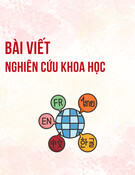

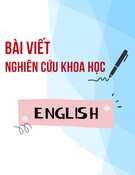
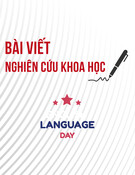
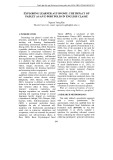
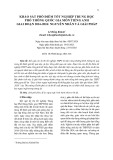
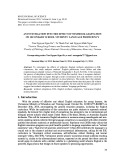
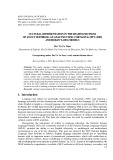
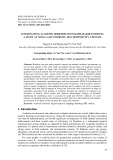


![Tài liệu Từ vựng tiếng Anh Trung cấp [mới nhất]](https://cdn.tailieu.vn/images/document/thumbnail/2025/20250913/nguyentuan250421@gmail.com/135x160/99491757910839.jpg)
![Tài liệu Từ vựng Tiếng Anh theo chủ đề [mới nhất]](https://cdn.tailieu.vn/images/document/thumbnail/2025/20250913/namdhuet@gmail.com/135x160/83251757753810.jpg)
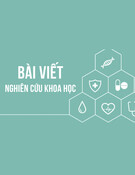

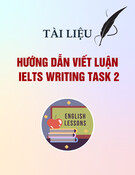
![Tài liệu Từ vựng tiếng Anh cho bé [chuẩn nhất/mới nhất]](https://cdn.tailieu.vn/images/document/thumbnail/2025/20250731/huadaithesang2509@gmail.com/135x160/18631754013896.jpg)








